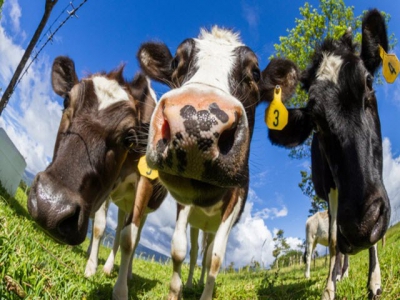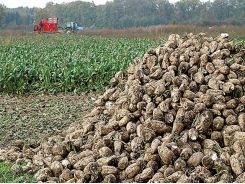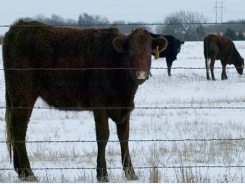Study: Cows fed functional oils have greater milk fat yield in comparison with those fed mo

Blended functional oils boost milk fat production, support dairy cow production during heat stress and could provide producers an alternative to ionophore use in diets, say researchers.
Photo © GettyImages/Charles Wollertz
An international team of researchers from Brazil and the US explored the use of a functional oil blend (FO) to replace monensin (MON) in dairy cattle feed during a period of heat stress.
“The objective of this study was to determine the effects of a blend of FO or MON on total tract digestibility of nutrients, ruminal fermentation, levels of glucose and urea in blood, thermal status, and milk yield and composition of dairy cows under a high-temperature humidity index environment,” the researchers said.
Researchers found that cows fed the monensin diet had reduced dry matter intake but did not see an alteration in total tract digestibility of nutrients or ruminal fermentation.
Both the additive functional oils and monensin raised serum urea concentration but did not alter serum glucose amounts.
The feed additives did not alter milk yield or fat-corrected milk, but cows getting the functional oils had higher milk fat content than those on monensin, they said. “This study did not show evidence that treatments can decrease body temperature, but FO may replace MON in diets to maintain milk fat concentration without affecting dry matter intake and milk yield of cows under heat stress,” they added.
Why functional oils, not monensin?
Despite advancement in cooling practices and systems, heat stress remains an expensive problem for the dairy industry, the researchers said.
Cows affected by heat stress can have metabolic or health disorders, reductions in milk yield or quality and poorer reproductive performance.
“St-Pierre et al. (2003) estimated that heat stress imposes annual costs for the US dairy industry around $848.4m when optimum mitigation strategy is adopted whereas costs can reach US$1.5bn when no strategies are adopted to minimize the impacts of heat stress,” they said.
During heat stress periods, cows have altered respiration rates, changes in levels of metabolites and hormones in the blood and may have hepatic dysfunctions, they said.
Previously, ionophore antibiotics like monensin were used to improve animal performance by boosting the rate of propionate production, reducing methane production and lessoning ruminal ammonia accumulation, they said. But there also is evidence that adding monensin to cattle feeds increases rectal temperatures and respiration rate for cows both in thermal neutral or heat stress conditions.
Additionally, the use of ionophore antibiotics is being limited globally, they added.
Some research is suggesting that blends of plant extracts or functional oils may improve the performance of lactating cows, potentially by raising ruminal propionate levels, the researchers said. The functional oils used in the study – cashew nut shell liquid (CNSL) and castor oil (CO) – are considered functional oils because they have biological properties in addition to nutritional value.
Cashew nut shell liquid is generated by the cashew nut industry and includes “resorcinolic and alkylphenolic oil, with anacardic acid (3-n-pentadecylsalicylic acid), cardanol (3-n-pentadecylphenol), cardol (5-n-pentadecylresorcinol), and methylcardol (2-methyl-5-n-pentadecylresorcinol) as bioactive compounds,” they said. It has been linked to reduced methanogenesis and increased ruminal proportions of propionate for non-lactating cows.
It also may limit rumen methane emissions and slightly improve total tract neutral detergent fiber (NDF) digestibility for cows that are lactating, they said.
Castor oil contains ricinoleic acid and has the ability to modulate ruminal bacterial populations when fed to beef cows, they said. It may support performance in lactating cows.
Both oils are considered biologically active and as having gastro-protective, anti-inflammatory and antioxidant properties, the researchers said. “These properties may be more beneficial in cows impacted by heat stress since hyperthermia alone promotes the production of reactive oxygen and nitrogen species that damage cell membranes and tight junctions of intestinal epithelium,” they added.
Although both oils have been fed to dairy cows, little is known about how they would affect cows facing heat stress, they said. “We hypothesized that FO could replace MON in diets of dairy cows while improving thermal status and performance,” they added.
Feeding trial details
In the feeding trial, 36 cows were fed one of three diets for a period of six weeks, the researchers said.
The diets included a control diet of corn silage and concentrate without feed additives, that diet with added functional oils comprised of 500mg/kg dry matter (DM) of cashew nut shell liquid and castor oil, or the control diet with monensin at 22mg/kg DM, they said. Additives were mixed into a concentrated and added to the total mixed ration (TMR).
Refusals were recorded and corn silage and ort samples were collected daily, while concentrate was sample weekly, they said. Fecal samples were collected for analysis on consecutive days in week 3 and 5 of the feeding trial.
Ruminal digesta was collected on the final day of the experiment before and at 2, 4, 6, 8, 10, 12, 14 and 16h after the morning feeding, the researchers said. Ruminal fluid pH was measured and samples were analyzed for NH3-N and volatile fatty acids.
Blood samples were taken during weeks 1, 4, and 6 to check for blood glucose and urea levels, the researchers said.
Additionally, milk yield was noted daily and samples were collected multiple times per week to test for milk components including amounts of fat, lactose and true protein, they said.
Results
Overall, cows on the MON diet had a reduced intake of dry matter and organic matter compared to cows on the other diets, the researchers said. They also tended to have a lower intake of crude protein than those on the control diet.
“Functional oils increased milk fat production, and can be used in place of monensin without affecting feed intake, digestion, ruminal fermentation, and thermal status of dairy cows under a high THI [temperature humidity index] environment,” they said. “On the other hand, MON decreased feed intake and had no effect on animal performance.”
The diets did not alter apparent total tract digestibility of nutrients, ruminal pH or NH3-N concentration, the researchers said. No interaction between feed and time was found for dry matter intake.
Feed additives also were not found to change ruminal volatile fatty acid proportions (VFA) or total VFA concentration, they said. No connection between feed and time was found for ruminal fermentation variables.
Both feed additives increased the blood urea concentration, they said. However, neither altered blood glucose level, heart rate, respiration rate or rectal temperatures.
“Feed additives had no effect on yields of milk, FCM, and solids, except for fat,” the researchers said. “Cows fed FO had greater milk fat content compared to those fed MON, and FO tended to increase milk fat production in relation to MON.”
“No interaction effect between treatment and time was observed on milk yield and composition, and feed efficiency,” they added.
Source: Animal Feed Science and Technology
Authors: L.Ghizzi, T. Del Valle, C. Takiya, G. da Silva, E. Zilio, N. Grigoletto, L. Martello, F. Rennó
Có thể bạn quan tâm
Phần mềm

Phối trộn thức ăn chăn nuôi

Pha dung dịch thủy canh

Định mức cho tôm ăn

Phối trộn phân bón NPK

Xác định tỷ lệ tôm sống

Chuyển đổi đơn vị phân bón

Xác định công suất sục khí

Chuyển đổi đơn vị tôm

Tính diện tích nhà kính

Tính thể tích ao hồ




 Alternative antimicrobial chitosan may boost dairy cow feed…
Alternative antimicrobial chitosan may boost dairy cow feed…  Cow/calf producers should estimate winter feed needs
Cow/calf producers should estimate winter feed needs